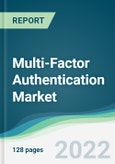The multi-factor authentication market is expected to grow at a CAGR of 14.12%, reaching a market size of US$37.266 billion in 2029 from US$19.255 billion in 2024.
MFA is an electronic authentication security technology that authenticates and allows a user access to an application, web portal, or VPN through various authentication mechanisms. MFA is intended to create barriers against unauthorized access to a target such as a computing device, network, physical location or database. This boosts security since users must identify themselves through another method in addition to username and password combinations. Nonetheless, although usernames and passwords cannot be disregarded, they can still be vulnerable to brute force attacks and hacking activities. Enforcing an MFA factor that serves as a thumbprint or physical hardware key increases the organization's confidence in its security.
The rising use of cloud networking by numerous public and private institutions in their fundamental functions, and consequently the possibility of security attacks, have all contributed to an increase in the craving for multifactor authentication solutions. The universe of MFA is subdivided into groups according to its model types, application areas and regional classifications.
MFA is an electronic authentication security technology that authenticates and allows a user access to an application, web portal, or VPN through various authentication mechanisms. MFA is intended to create barriers against unauthorized access to a target such as a computing device, network, physical location or database. This boosts security since users must identify themselves through another method in addition to username and password combinations. Nonetheless, although usernames and passwords cannot be disregarded, they can still be vulnerable to brute force attacks and hacking activities. Enforcing an MFA factor that serves as a thumbprint or physical hardware key increases the organization's confidence in its security.
The rising use of cloud networking by numerous public and private institutions in their fundamental functions, and consequently the possibility of security attacks, have all contributed to an increase in the craving for multifactor authentication solutions. The universe of MFA is subdivided into groups according to its model types, application areas and regional classifications.
Multi-Factor Authentication Market Drivers:
- High demand for online transactions
Multi-Factor Authentication Market Geographical Outlook
- The Asia Pacific is witnessing exponential growth during the forecast period
Reasons for buying this report::
- Insightful Analysis: Gain detailed market insights covering major as well as emerging geographical regions, focusing on customer segments, government policies and socio-economic factors, consumer preferences, industry verticals, other sub- segments.
- Competitive Landscape: Understand the strategic maneuvers employed by key players globally to understand possible market penetration with the correct strategy.
- Market Drivers & Future Trends: Explore the dynamic factors and pivotal market trends and how they will shape up future market developments.
- Actionable Recommendations: Utilize the insights to exercise strategic decision to uncover new business streams and revenues in a dynamic environment.
- Caters to a Wide Audience: Beneficial and cost-effective for startups, research institutions, consultants, SMEs, and large enterprises.
What do businesses use our reports for?
Industry and Market Insights, Opportunity Assessment, Product Demand Forecasting, Market Entry Strategy, Geographical Expansion, Capital Investment Decisions, Regulatory Framework & Implications, New Product Development, Competitive IntelligenceReport Coverage:
- Historical data & forecasts from 2022 to 2029
- Growth Opportunities, Challenges, Supply Chain Outlook, Regulatory Framework, Customer Behaviour, and Trend Analysis
- Competitive Positioning, Strategies, and Market Share Analysis
- Revenue Growth and Forecast Assessment of segments and regions including countries
- Company Profiling (Strategies, Products, Financial Information, and Key Developments among others)
The Multi-Factor Authentication market is segmented and analyzed as follows:
- By Type
- Two-Factor Authentication
- Three-Factor Authentication
- Four-Factor Authentication
- Five-Factor Authentication
- By Application
- BFSI
- Defence
- Travel and Transport
- Others
- By Geography
- North America
- USA
- Canada
- Mexico
- South America
- Brazil
- Argentina
- Others
- Europe
- Germany
- UK
- France
- Spain
- Others
- Middle East and Africa
- Saudi Arabia
- Israel
- Others
- Asia Pacific
- China
- Japan
- India
- Indonesia
- South Korea
- Others
- North America
Table of Contents
1. INTRODUCTION
2. RESEARCH METHODOLOGY
3. EXECUTIVE SUMMARY
4. MARKET DYNAMICS
5. MULTI-FACTOR AUTHENTICATION MARKET BY TYPE
6. MULTI-FACTOR AUTHENTICATION MARKET BY APPLICATION
7. MULTI-FACTOR AUTHENTICATION MARKET BY GEOGRAPHY
8. COMPETITIVE ENVIRONMENT AND ANALYSIS
9. COMPANY PROFILES
Companies Mentioned
Some of the key companies profiled in this Multi-Factor Authentication Market report include:- EMC Corporation (RSA)
- Thoma Bravo (Entrust)
- Thales Group
- ASSA ABLOY (HID Global)
- One Identity (OneLogin)
- Okta (AuthO)
- Avago Technologies Limited (Broadcom Inc)
- Microsoft
Methodology

LOADING...
Table Information
| Report Attribute | Details |
|---|---|
| No. of Pages | 128 |
| Published | September 2024 |
| Forecast Period | 2024 - 2029 |
| Estimated Market Value ( USD | $ 19.26 billion |
| Forecasted Market Value ( USD | $ 37.27 billion |
| Compound Annual Growth Rate | 14.1% |
| Regions Covered | Global |
| No. of Companies Mentioned | 9 |









